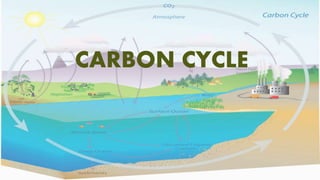
Carbon cycle
- 1. CARBON CYCLE
- 2. WHAT ISTHE CARBON CYCLE • All life is based on the element carbon that has the symbol ‘C’ and the atomic number 6. • Carbon is the major chemical constituent of most living matter including human-beings. Yet by weight, carbon is not one of the most abundant elements on the Earth‘s crust. • Carbon moves in complex chemical and physical transfers from sources, or reservoirs, where carbon is released, to sinks, where carbon is taken up. • This movement is the global carbon cycle.
- 3. WHAT ISTHE CARBON CYCLE • Earth's atmosphere, ocean, land, and living things can be both sources and sinks of carbon. • The processes of photosynthesis, respiration, death, and decomposition move carbon through the carbon cycle partly as carbon dioxide. • In Earth's atmosphere, CO2 is only about 0.03% by volume, but it is an important "greenhouse" gas. It traps in the lower atmosphere much of the heat radiated from the Earth's surface.
- 4. WHAT ISTHE CARBON CYCLE The carbon cycle is therefore the circulation of carbon atoms in the biosphere as a result of photosynthetic conversion of carbon dioxide into complex organic compounds by plants which are consumed by other organisms: the carbon returns to the atmosphere in the form of carbon dioxide as a result of respiration, decay by fungi, bacteria and combustion of fossil fuels
- 5. SOURCES OF CARBON • Carbon is stored on the planet in the following major reservoirs: • (1) as organic compounds (e.g. sugar, starch) in living and dead organisms in the biosphere; • (2) as the gas carbon dioxide (CO2 ) and methane (CH4 ) in the atmosphere; • (3) as organic matter in soil; • (4) in the lithosphere as fossil fuel and sedimentary rocks such as limestone (including chalk) and dolomite; • (5) in the oceans as dissolved hydrocarbons and as calcium carbonate in the shells of marine creatures (e.g. coral).
- 6. HOW DOESTHE CARBON CYCLEWORK • When it’s in the atmosphere, carbon is combined with two oxygen atoms making a molecule called carbon dioxide (CO2). • Plants absorb carbon dioxide and sunlight to make their own food.This process is called photosynthesis. In this process, carbon becomes part of the plant, and the plant releases oxygen. • When the plants die and are buried under layers of earth for millions of years, they may become fossil fuels like coal, oil and natural gas.
- 7. HOW DOESTHE CARBON CYCLEWORK • When these fuels are burned, the carbon is released back to the atmosphere. • Some of it is as carbon monoxide (where carbon is combined with only one oxygen atom), and this is a poisonous gas. • The rest combines with two oxygen atoms to again form CO2. Animals do just the opposite as plants.They inhale air from the atmosphere, use the oxygen, and exhale CO2.
- 8. HOW DOESTHE CARBON CYCLEWORK
- 9. WHY ISTHE CARBON CYCLE IMPORTANT • The carbon cycle is essentially nature's way of reusing carbon atoms in different ways and in varying places. • The carbon cycle is vitally important to life on earth • Through photosynthesis and respiration, it is the way the earth produces food and other renewal resources
- 10. WHY ISTHE CARBON CYCLE IMPORTANT • Through decomposition it serves as the earth’s waste disposal system • Carbon containing gases in the atmosphere affect the earth’s climate. Increased carbon dioxide in the atmosphere has been responsible for half of the climate warming observed in recent decades • Carbon dioxide (CO2) plays a key role in trapping heat in the atmosphere—one of the basic mechanisms behind the greenhouse effect, which raises temperatures near the earth’s surface. • Another factor that makes the cycling of carbon important is that carbon plays a central role in combustion—burning—and in the last 200 years we have dramatically changed the carbon cycle through burning fossil fuels, which has released large volumes of CO2 into the atmosphere.
- 11. HUMAN EFFECTS ONTHE CARBON CYCLE • The carbon cycle has major effects on global climate • The burning of fossil fuels at the presently alarming rate increases global warming. This is due to the increasing amount of greenhouse gases, specifically CO2, which capture heat easily thus increasing global temperature. • At present, there is a fear of the greenhouse effect increasing global warming to an almost dangerous high. The excess carbon dioxide from the burning of fossil fuels is responsible for the gradual yet constant rise in temperature over the past few decades.
- 12. HUMAN EFFECTS ONTHE CARBON CYCLE • Also, substantial areas of forest have been cut down, removing a pathway for CO2 absorption. Consequently, recent times have seen the amount of CO2 in the air increase and the amount of oxygen decrease. • Because there is so much oxygen in the air, the oxygen drop is hardly noticeable, but as there is very little CO2 (0.038% of the atmosphere) the extra CO2 from burning and deforestation has caused a dramatic rise. • This has contributed to an enhanced greenhouse effect in recent decades. • Given the potentially serious consequences for the earth’s climate of this enhanced greenhouse effect, great importance is now placed on ways of reducing CO2emissions and on reducing the CO2 already in the air.
